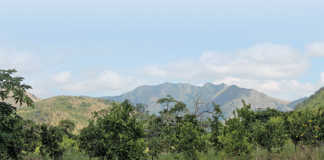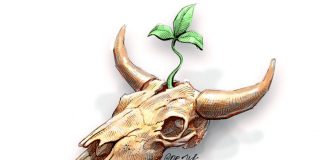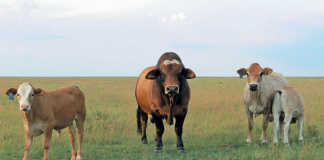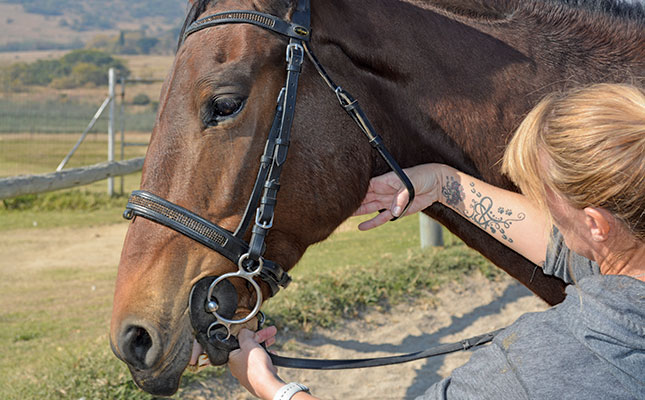
Saddle fitting is a well-known vocation in the equine industry, and the importance of a saddle that fits well is undisputed. Many studies have been conducted on the effect of a poorly fitting saddle on a horse’s physiology, its ability to perform optimally, and its general well-being, psychology and willingness to work.
In contrast, the importance of a bridle that fits well has been largely ignored, and scientific studies on the subject are scant.
“Bridles are one of the most unacknowledged pieces of tack that riders own,” says Vicki Sokolich, an equine complementary care expert and owner of Equi-Silhouette.
“There are numerous types of bridles that have been manufactured for different disciplines. However, they’re all based on the basic bridle: the snaffle bridle (English), or the traditional Western bridle (headstall). The differences between these two are the pressure points that each places on the horse’s head.”
The pressure points are the poll/brow, nose, and side of the face. “Each bridle has a suggested fit in order to maximise your horse’s comfort for the discipline. It’s imperative that you follow these guidelines to ensure you’re not impinging on the vital cranial nerves,” says Sokolich.
In his article, ‘Bridle fit is as important to horses as saddle fitting’, Jochen Schleese, a certified master saddler and equine ergonomist, writes: “The most severe problems arise in the neck/base of the skull if the bridle fits badly (where the headpiece lies), but a noseband or flash that’s buckled too tightly will also cause problems here.”
Behavioral problems
Sokolich explains that all the pressure points of the simple snaffle bridle are at the exact points where the sensitive facial nerves originate.
“All parts of the horse’s head should have the freedom to move when wearing any bridle, so that the muscles of the ears, jaw, lips and nose are not restricted,” she says.
If any parts of the bridle are too tight or don’t fit properly, all sorts of behavioural and physical problems may arise.
“Horses may become head-shy, or toss their heads. They may also demonstrate a lack of chewing, salivation or engagement, and an unwillingness to move. Physical symptoms include rubs and sores, ruffled hair or hair loss, and hair turning white. Horses may grind their teeth and bite their tongues. There may also be tension in the poll and neck, and breathing may be restricted,” she says.
A complex network of nerves branches off from the spinal cord into parts of the body and limbs. However, the cranial nerves branch off directly from the brain into the face. These are important for the functioning of many of the horse’s systems, and any damage to these nerves can cause widespread problems.
The neck
According to Schleese, the bursa (fluid-filled sacs) between the nuchal ligament, which helps the horse support its neck, and the first two cervical vertebrae prevent the ligament from rubbing on the vertebrae and getting damaged.
“However, the bursa cannot withstand a lot of pressure, and will react to a too-tightly buckled bridle by increasing fluid production and swelling.”
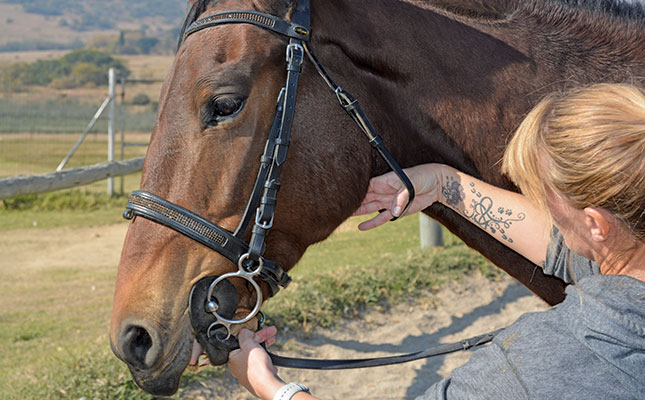
Swollen bursa present in behavioural problems, with the horse tossing its head and refusing contact with the bit.
“When it really hurts, the horse may ‘invert’ its neck in an attempt to escape the pain. The muscles of the topline may begin to atrophy, and the horse develops a ‘ewe’ neck,” writes Schleese.
According to Sokolich, the horse should still be able to chew comfortably, even with its bridle on. A noseband that is too tight, for example, can cause cramping of the jaw muscles and pressure in the neck.
“This muscle ‘bracing’ will affect the horse’s entire musculature and ability to engage. Some horses are in such pain around their heads that riders may have misdiagnosed them as being head-shy,” says Schleese.
The two acupuncture points located in the headpiece area influence neck flexibility, back movement, and collection ability. A flash or noseband buckled too tightly will irritate these points.
“This further influences the flexibility of the haunches as well as proper breathing,” writes Schleese.
A bridle that is too tight may place too much pressure at the base of the horse’s skull. Schleese explains that as the nerve that runs through this area is connected to the skin at the horse’s ears, the horse may become head-shy, and be reluctant to have its ears touched.
“This nerve also connects to the tongue musculature, possibly leading to further problems in the forelegs, since the muscles here are also connected to many of those muscles responsible for movement in the forelegs.”
The noseband
A tight-fitting noseband presses on the infraorbital nerve that comes directly out at the zygomatic arch, which is right under the noseband. The noseband may also place pressure on the exit point of the branches of two nerves, namely the nervus trigeminus and nervus facialis.
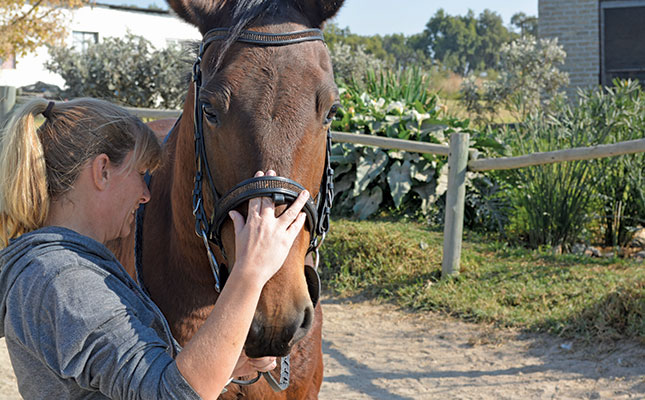
“The bridle thus needs to be correctly fitted and buckled in order not to rub against these bone projections. Although pressure on the bone won’t necessarily cause any damage to the bone itself, it will cause pain,” writes Schleese.
If the brow band is too tight, it may put pressure on the ear salivary gland. This will result in the production of excess saliva, which the horse won’t be able to swallow.
As the hyoid, which is connected to a nerve in the ear, lies beneath this gland, too much pressure can disturb the animal’s balance.
Nosebands and flashes positioned too low on the face may ‘close’ the nostrils and affect the horse’s breathing ability.
“This can also cause heat build-up in the lungs,” explains Schleese. “The noseband and flash can also cause problems with the mucous membranes in the mouth. If these are too tight, the edges of the teeth in the upper jaw will press against these, as well as against the skin of the cheeks, and can cause injuries.”
A properly fitting bridle
Sokolich stresses that bridles are not a “one-size-fits-all”.
“Take the specific measurements of your horse’s head in order to ensure an accurate fit. Bridles should be considered a DIY craft project, as not all horses are the same size and should thus not be treated the same.”
Dover Saddlery lists the following guidelines to ensure proper bridle fit:
- The headpiece
Measure from one corner of your horse’s mouth, over the poll, to the other corner of its mouth. - Brow band
Measure from the back edge of the horse’s ear, around its forehead, to the back edge of the other ear. “The ideal position is one to two finger widths below the front of its ears. Ensure that the brow band is long enough so it won’t pull the headpiece into the back of the horse’s ears. Conversely, if it sticks out, forms a gap in front of the forehead, or wiggles when the horse moves, the brow band is too long,” says Sokolich. - Noseband
Measure around your horse’s muzzle at a point about two fingers below its cheekbones. You should always be able to fit two fingers comfortably under the noseband. “The placement and fit of the noseband will vary immensely depending on the type of bridle you’ve purchased,” explains Sokolich. “The snaffle noseband should be placed at least one finger’s width below the horse’s cheekbone; the tighter it is, the more pressure is exerted.” - Throatlatch
Measure from the back of the horse’s ear, under its throat, to the back of its other ear.
“Fasten the throatlatch so that you can fit four fingers between it and the underside of your horse’s jaw, but not more. The throatlatch keeps the bridle in place. If it’s too loose, it can’t perform its function. If it’s too tight, it can hamper the horse’s breathing,” says Sokolich.
Email Vicki Sokolich at [email protected].
- Sources: Schleese, J. 2017. ‘Bridle fit is as important to horses as saddle fitting: Here’s why.’
- Schleese, J. 2017. ‘Fitting a bridle properly.’









